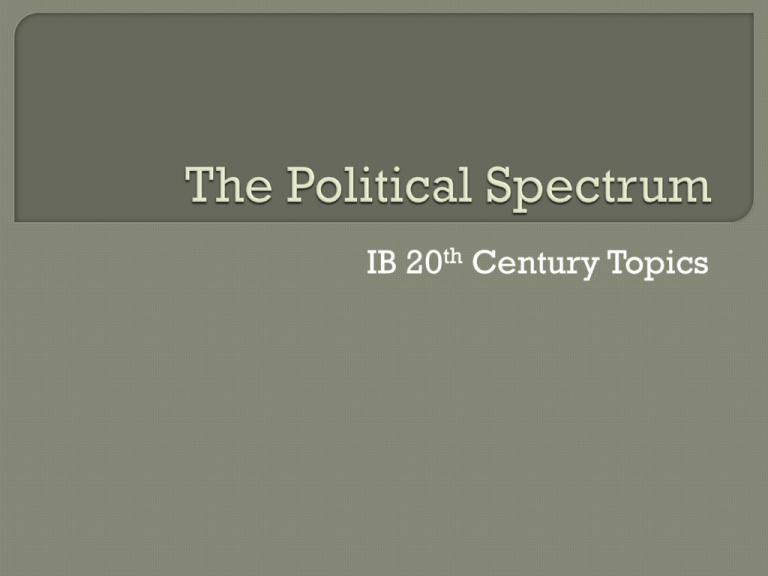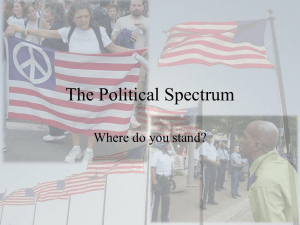The Political Spectrum
advertisement

IB 20th Century Topics The political spectrum is a term used to refer to the differences in ideology between the major political parties in the World A person’s views on the issues help determine where they fall on the political spectrum. The labels used on the spectrum are not pure categories, but they make up a continuum, or value line, and citizens and politicians fall somewhere on that line depending on what they believe. An aspect of a culture’s worldview A philosophical tradition Certain psychological attitudes A partisan tradition and set of positions on current political issues Two major factors shape political views. The first is how much change a person is willing to have within their society and government. The second deals with how much government involvement in the economy a person calls for. Others also bring in the question of how much freedom from government authority a leader is willing to give the people. Left______________Center______________Right Anarchy Radical Liberal Moderate Conservative Reactionary A philosophy of socialism demanding the end of government, capitalism and religion Revolution through “direct action” – terrorism and assassination No planning of future society and economy Against all forms of authority and private property Seen as being on the far left of the political spectrum, radicals call for wide-sweeping rapid change in the basic structure of the political, social, or economic system. They may be willing to resort to extreme methods to bring about change, including the use of violence and revolution. V.I. Lenin: Mastermind of the Russian Revolution and Father of the Soviet Union Revolutionary Extreme equality- socialism Violent rationale Anti-capitalist, illiberal, intolerant Act on behalf of workers, poor and marginalized social groups Communism Ernesto “Che” Geuvara pictured right. Che was an Argentine Marxist Revolutionary who was instrumental in the Cuban Revolution “It is better to die standing than to live on your knees.” -Che Guevara “One man with a gun can control 100 without one.” -Vladimir Lenin Trust in the ability of government to reform society. Promote social and economic equality Strong government regulation of the economy Social welfare programs Peaceful, gradual change May share viewpoints with both liberals and conservatives Patriotic, practical, and patient Value compromise and civility Consider both sides, use common sense Easiest group to persuade but dislikes conflict Sen. Barry Goldwater (R-AZ) is widely regarded as the father of the modern conservative movement People who hold conservative ideals favor keeping things the way they are or maintaining the status quo if it is what they desire. Conservatives are usually hesitant or cautious about adopting new policies, especially if they involve government activism in some way. They feel that the less government there is, the better. They agree with Jefferson’s view that “the best government governs least.” Seeks to preserve the best aspects of society and is skeptical of change Values liberty, order, tradition People with power are not to be trusted Favor low taxes, a strong national defense, tough laws against crime, free market capitalism, traditional family values Against abortion but favor the death penalty Hitler’s Mein Kampf is a typical reactionary manifesto Sitting on the far right of the ideological spectrum, reactionaries want to go back to the way things were—the “good ol’ days.” Often reactionaries are willing to use extreme methods, such as repressive use of government power, to achieve their goals. “The truth is that men are tired of liberty” –Benito Mussolini Extreme Violence: “Might Makes Right” In revolt against Modernity Irrational appeal to emotion, mythical visions, vengeance, racial or religious identity Against democracy, liberalism, capitalism, individualism, minorities, free speech, women’s rights, and cultural changes Though we have discussed the Political Spectrum on a one dimensional basis, many believe that they are overly simplistic for today's complex political landscape. On the standard left-right scale, how do you distinguish leftists like Stalin and Gandhi? It's not sufficient to say that Stalin was simply more left than Gandhi. There are fundamental political differences between them that the old categories on their own can't explain. 2008 Primaries 2008 Election Hmmmm…. Notice how Obama, McCain and Joe Biden switch their political views closer to the election…. Why is this?









